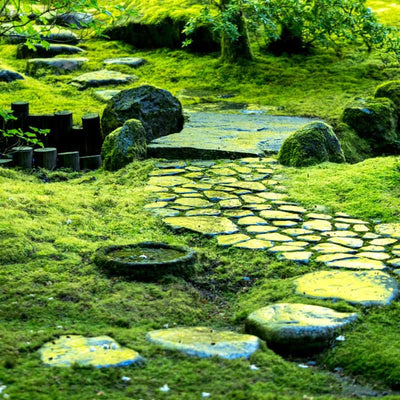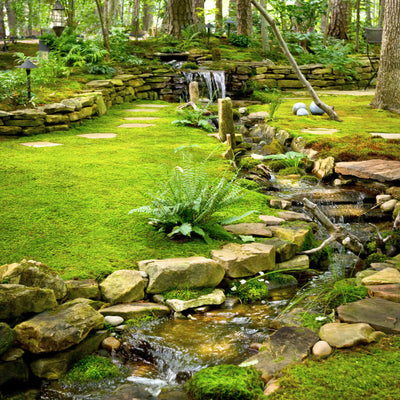The Contributions of Moss to The Environment
Apparently, the role of moss is still unknown to many in landscaping. While the focus is primarily on the blooming flowers, shrubs, and trees, the role of moss is equally critical in sustaining life and prettifying the garden. The fact that moss is low maintenance and grows in almost impossible conditions makes it a treasure that gardeners must work with. But why is it that moss is so ecologically impactful? More and more gardeners these days appear to understand the benefits moss has in helping the environment, so let's explore them.
What is Moss?
Moss is a tiny plant with no systemic circulation that grows into thick clumps or mats, often in wet or shady surroundings. In distinction to all flowering plants, mosses do not have flowers, seeds, or roots, and instead reproduce by means of spores.
Moss is an environmental specialist, with over 12 thousand variants, adapting to several ecologies across the globe. Within the entire flora, it begs an interesting epithet – for it grows in any condition… even in crevices of rocks, walls, roofs, trees and many more.
The most appealing types include carpet moss, cushion moss, sheet moss, hair cap moss, and tree moss.
Moss Landscaping Benefits
Commonly, when landscaping is mentioned, the first things which come to the audience's mind are a well-maintained lawn, lively bountiful flowers, and trees. Moss, however, has its own unique benefits to landscaping that are often unappreciated.
Require Very Little Care
Moss does not require watering or mowing, and does not require routine fertilizing. Once established, moss requires very little maintenance. This is great for those who are busy working in the garden or those who wish to minimize the effort spent maintaining their yard. Unlike grass, moss does not need to be maintained, hence does not require mowing, fertilizing, or the application of pesticides.
Conserves Water
Moss is very effective in absorbing and retaining water. It is capable of soaking up water equating to almost 10 times its weight. Due to this ability, moss reduces the erosion of soil, and loss of moisture, which makes it an ideal plant to grow in flooded regions or regions with high runoff. Moss also assists in rainfall capture by absorbing water, and reducing the formation of puddles, reducing the waterlogged garden.
Control Erosion
Moss helps to hold the soil with its root-like rhizoids. This combats soil erosion, especially in sloped areas and places with poor soil structure. In addition, its dense matting makes it harder for soil to wash away during heavy rain, so your garden will remain intact and healthy.
Air and Water Purification
Moss absorbs and removes heavy metals and even toxins from the environment. Its natural processes improve the surrounding air by absorbing and purifying the air of carbon dioxide while emitting oxygen. This could be beneficial in a city where air pollution is a problem. Moss can also remediate water by concentrating toxins, thus purifying it.
Biodiversity Support
Moss has the unique ability to establish conditions favorable for the development of numerous other small plants and even microorganisms. Its thick mats of moss also provide a source of shelter to numerous insects and arachnids, as well as many other small animals. Such organisms often go unrecognized, thus mosses are vital for the development of a balanced ecosystem. When moss is grown in a garden, its positive impact of biodiversity results in a balanced ecosystem made of plants, animals, and microorganisms.
Is Moss Eco-Friendly?
Moss can especially be seen as an environmental-friendly plant as it uses no fertilizers or pesticides which helps in the elimination of chemical runoff to surrounding water bodies. Moreover, it helps in climate change mitigation as a sink for CO2. It represents a special type of biodiversity as it can thrive in conditions which are inhospitable to other plant species. Hence, it can be beneficial in highly degraded or stressed ecosystems.
Do You Think Moss Removes More CO2 Than Trees?
The removal of forests and the burning of fossil fuels is an enormous contribution to the atmosphere's carbon dioxide. Mosses illustrate the concept of carbon sink by absorbing and storing atmospheric CO2. Furthermore, despite the diminutive size of moss in comparison to trees, their considerable abundance, especially within the temperate forest biome, is indeed of great significance.
Moss is undoubtedly useful, but are there any moss downsides?
Moss Downsides
Moss is useful in so many ways, but it does have some downsides. Moss does not grow well in regions that are subject to extreme temperatures and extended periods of droughts. Moss does like to grow in cool shady areas, also making it challenging to thrive in open exposed sunny arid regions. Even more, moss is fragile in nature and carelessly stepping on or disturbing the ecosystem moss is in can ruin its form and structure topography.
Is Moss Better for the Environment Than Grass?
Moss might be more advantageous than grass for the environment in certain aspects. Grass needs lots of water and fertilizers and needs frequent pesticides to keep a lawn. In contrast, moss needs none of this, which makes it more beneficial to the environment. In addition, moss also saves more water, reduces soil erosion, and soil erosion and water retention, which the grass does not do as efficiently. In the case of gardens or regions with little or no soil, patches of moss are a better option than lawns of grass.
If you have any questions about moss or if you have any other plant needs, don’t hesitate to contact us at customerservice@tennesseewholesalenursery.com, we’d love to hear from you!
Check out our moss in stock.
Would you like to maintain your garden with moss and also enjoy the environmental benefits of it? We have a large stock of moss and other plants on our online store. We ship across the country so today is the best chance to transform your garden.
FAQs
What is the environmental impact of moss?
Moss is good for the environment in many ways, including its ability to retain water, absorb carbon dioxide, and prevent erosion. It is certainly an air-purifying moss and, therefore, does not cause negative effects in the garden. Moss helps reduce the use of fertilizers and pesticides which contribute to worse and worse ecosystem health.
Is moss environmentally friendly?
Yes, it is as there is no use of many fertilizers, and its natural thriving conditions are wide-ranged. Moss is also sustained as it absorbs carbon dioxide which improves the quality of the atmosphere.
Is it bad to have moss growing in your yard?
No. This is not the case as moss growing in the backyard is quite useful. It helps retain water, and is useful to areas which are shady and covered in moisture.
Does moss remove more CO2 than trees?
Mosses may not absorb as much CO2 as trees, but they do serve an important role in capturing and maintaining it within the ecosystem. Although mosses regulate and absorb ‘atmospheric’ carbon through photosynthesis, it does not do so as efficiently as trees.
What are the downsides of moss?
Shade, as well as moist and cool environments that are not too sunny, are important for mosses’ development. Dry and bright areas are not suited for their growth. In addition, mosses are thin. For that reason, they are easily crushed and damaged, especially by foot traffic.
Is moss better for the environment than grass?
Definitely, moss is more eco-friendly than grass. It does not need synthetic fertilizers, pesticides and does not need to be mowed. In addition, mosses help relieve soil erosion much more than grass does, which aids land restoration. In these ways, moss is much more effective for landscaping.






